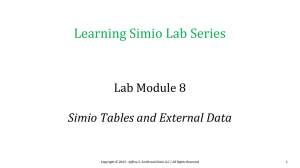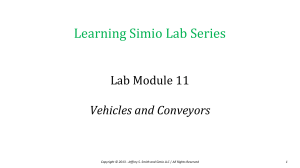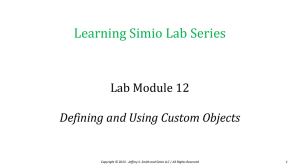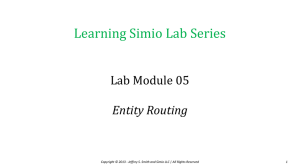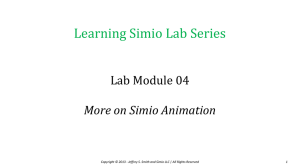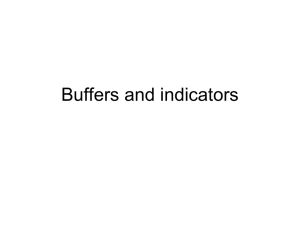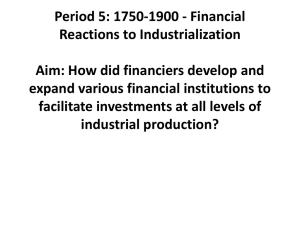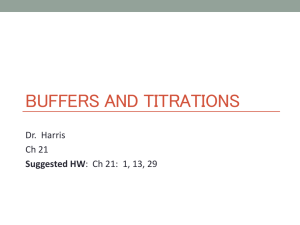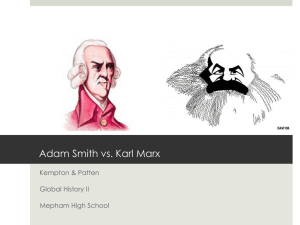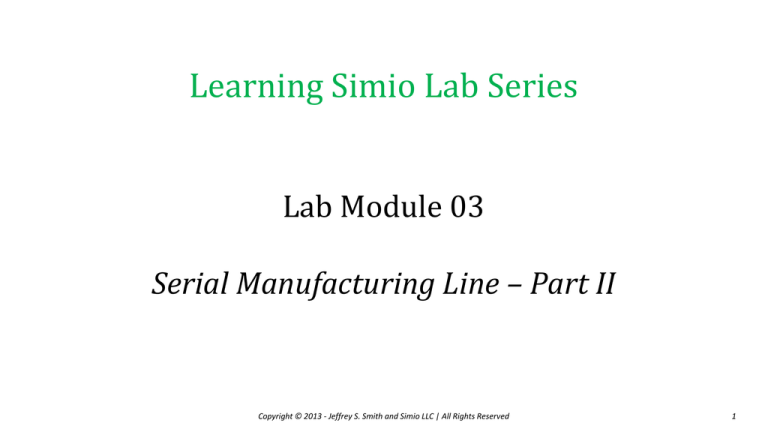
Learning Simio Lab Series
Lab Module 03
Serial Manufacturing Line – Part II
Copyright © 2013 - Jeffrey S. Smith and Simio LLC | All Rights Reserved
1
Objectives and Outline
• Lab Objectives
–
–
–
–
–
Continue learning basic Simio modeling
Learn the event mode for the Source object
Learn about buffer capacities for the Server Object
Learn about reference properties
Learn the basics of dynamic pie charts and status plots
• Lab Outline
–
–
–
–
Video 1 – Describe the system and develop the initial Simio model.
Video 2 – Add buffer capacities, introduce and use reference properties.
Video 3 – Described Resource States and added pie charts and status plots.
Video 4 – Assignments.
Copyright © 2013 - Jeffrey S. Smith and Simio LLC | All Rights Reserved
2
Video 1 – System Description and Initial Model
M1
M2
M3
M4
Capacity Analysis
Parts are continuously available (infinite supply) and there is infinite demand (i.e.,
we can sell all that we can make)
Processing times at each station are exponential with mean of 1 minute. The
buffers between stations are finite and we’re interested in determining the impact
of buffer size on system capacity.
Copyright © 2013 - Jeffrey S. Smith and Simio LLC | All Rights Reserved
3
Video 2 – Capacitated Buffers and Reference Properties
M1
M2
M3
M4
Capacity Analysis
Parts are continuously available (infinite supply) and there is infinite demand (i.e.,
we can sell all that we can make)
Processing times at each station are exponential with mean of 1 minute. The
buffers between stations are finite and we’re interested in determining the impact
of buffer size on system capacity.
Copyright © 2013 - Jeffrey S. Smith and Simio LLC | All Rights Reserved
4
Reference Properties
• Using a reference to a model property to specify the value for an object property.
Copyright © 2013 - Jeffrey S. Smith and Simio LLC | All Rights Reserved
5
Video 3 – ResourceStates, Pie Charts, Status Plots
M1
M2
M3
M4
Capacity Analysis
Parts are continuously available (infinite supply) and there is infinite demand (i.e.,
we can sell all that we can make)
Processing times at each station are exponential with mean of 1 minute. The
buffers between stations are finite and we’re interested in determining the impact
of buffer size on system capacity.
Copyright © 2013 - Jeffrey S. Smith and Simio LLC | All Rights Reserved
6
Video 3 – ResourceStates, Pie Charts, Status Plots
Copyright © 2013 - Jeffrey S. Smith and Simio LLC | All Rights Reserved
7
Video 4 - Assignments
1. Create experiment responses for the average numbers of parts in the buffers between
M1 and M2, M2 and M3, and M3 and M4.
2. Create a status plot showing the average numbers of parts in the same buffers.
3. For the following three configurations, assume that you have 20 total buffer slots to
distribute between the three buffers (i.e., (7, 3, 10) has a capacity 7 buffer between
M1 and M2, a capacity 3 buffer between M2 and M3, and a capacity 10 buffer
between M3 and M4). Find the buffer allocation that maximizes throughput of the
line.
Processing Time Distribution
M1
M2
M3
M4
A
Exponential(1)
Exponential(1.1)
Exponential(1.2)
Exponential(1.1)
B
Triangular(.5, 1, 1.5)
Triangular(.5, 1, 1.5)
Triangular(.5, 1, 1.5)
Triangular(.5, 1, 1.5)
C
Uniform(1, 2)
Uniform(.5, 2.5)
Exponential(1.5)
Uniform(1, 2)
Copyright © 2013 - Jeffrey S. Smith and Simio LLC | All Rights Reserved
8
Video 4 - Assignments
4. Supposed that there is a 5% probably of fallout at each machine. In other words, 5%
of parts processed at each machine are bad and exit the system without proceeding to
the “next” machine in the system. Modify your model to reflect this change.
5. Determine whether the optimal buffer configurations from question 3 change as a
result of the part fallout.
• Note that you should justify your choice of
– Replication length;
– Warmup period length; and
– Number of replications
for questions 3 and 5
Copyright © 2013 - Jeffrey S. Smith and Simio LLC | All Rights Reserved
9

